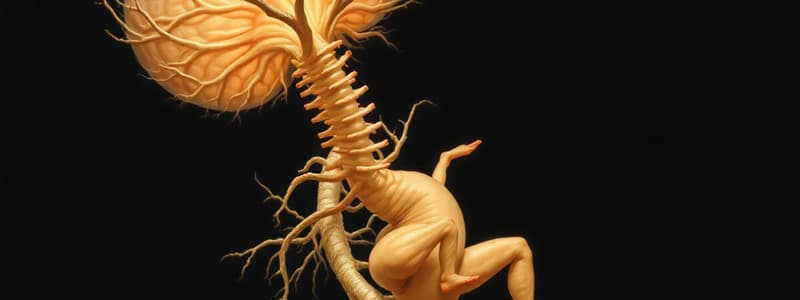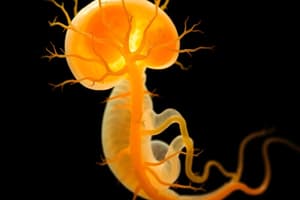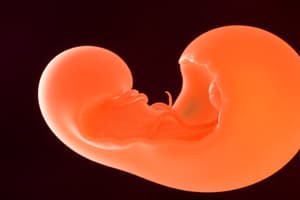Podcast
Questions and Answers
The Planar cell polarity pathway is essential for neural tube closure.
The Planar cell polarity pathway is essential for neural tube closure.
True (A)
Xdd1 disrupts only the Canonical Wnt signaling pathway.
Xdd1 disrupts only the Canonical Wnt signaling pathway.
False (B)
Mutations in the vangl gene are associated with neural tube defects.
Mutations in the vangl gene are associated with neural tube defects.
True (A)
Xdsh-D2 affects both the Canonical and Planar cell polarity pathways.
Xdsh-D2 affects both the Canonical and Planar cell polarity pathways.
Defects in the Planar cell polarity pathway can lead to craniorhachischisis.
Defects in the Planar cell polarity pathway can lead to craniorhachischisis.
Neurulation involves the transformation of the neural plate into the neural tube.
Neurulation involves the transformation of the neural plate into the neural tube.
All chordates possess a notochord at some stage of their development.
All chordates possess a notochord at some stage of their development.
The primary neurulation process occurs exclusively in mammalian embryos.
The primary neurulation process occurs exclusively in mammalian embryos.
Activated BMP signaling promotes the formation of neural tube defects.
Activated BMP signaling promotes the formation of neural tube defects.
Neurula refers to a stage in embryo development before the neural plate forms.
Neurula refers to a stage in embryo development before the neural plate forms.
E-cadherin and N-cadherin are involved in the transition during primary neurulation.
E-cadherin and N-cadherin are involved in the transition during primary neurulation.
The notochord is the only distinguishing feature observed in chordates.
The notochord is the only distinguishing feature observed in chordates.
Primary neurulation occurs in the chick embryo as a straightforward and uniform process.
Primary neurulation occurs in the chick embryo as a straightforward and uniform process.
The DEP domain is linked to the Canonical Wnt signaling pathway.
The DEP domain is linked to the Canonical Wnt signaling pathway.
Mutations in the vangl gene specifically result in neural tube failure due to disruption in the planar cell polarity pathway.
Mutations in the vangl gene specifically result in neural tube failure due to disruption in the planar cell polarity pathway.
The Xdd1 protein solely disrupts the planar cell polarity pathway.
The Xdd1 protein solely disrupts the planar cell polarity pathway.
Craniorhachischisis is a condition resulting from defective planar cell polarity and neural tube closure.
Craniorhachischisis is a condition resulting from defective planar cell polarity and neural tube closure.
The PDZ domain is unique to the canonical Wnt signaling and has no relation to planar cell polarity.
The PDZ domain is unique to the canonical Wnt signaling and has no relation to planar cell polarity.
Neurulation results in the formation of the neural tube from the neural plate.
Neurulation results in the formation of the neural tube from the neural plate.
All vertebrates exhibit a notochord only during their adult stage.
All vertebrates exhibit a notochord only during their adult stage.
Primary neurulation is not observed in non-mammalian species.
Primary neurulation is not observed in non-mammalian species.
BMP signaling has a role in promoting neural tube formation.
BMP signaling has a role in promoting neural tube formation.
Pharyngeal slits are exclusive to vertebrates and do not appear in any other chordates.
Pharyngeal slits are exclusive to vertebrates and do not appear in any other chordates.
Primary neurulation can exhibit variations in mechanisms across different species.
Primary neurulation can exhibit variations in mechanisms across different species.
E-cadherin and N-cadherin play no role in the neurulation process.
E-cadherin and N-cadherin play no role in the neurulation process.
The term 'neurula' refers to a stage after the formation of the neural tube.
The term 'neurula' refers to a stage after the formation of the neural tube.
The forebrain is also known as the prosencephalon.
The forebrain is also known as the prosencephalon.
Rhombomeres are structures found in the midbrain.
Rhombomeres are structures found in the midbrain.
Ephrin and ephrin receptor expression leads to the formation of rhombomeres in the primitive hindbrain.
Ephrin and ephrin receptor expression leads to the formation of rhombomeres in the primitive hindbrain.
The medulla is responsible for sleep regulation.
The medulla is responsible for sleep regulation.
Branchial arches are also known as pharyngeal arches.
Branchial arches are also known as pharyngeal arches.
The hindbrain is also referred to as the rhombencephalon.
The hindbrain is also referred to as the rhombencephalon.
At 30 hours post-fertilization (hpf), the posterior neural tube has not yet begun to constrict.
At 30 hours post-fertilization (hpf), the posterior neural tube has not yet begun to constrict.
Temperature regulation is a function associated with the cerebellum.
Temperature regulation is a function associated with the cerebellum.
Ephrin A & B are classified as 'receptors'.
Ephrin A & B are classified as 'receptors'.
KROX20 expression serves as a marker for rhombomere boundary formation.
KROX20 expression serves as a marker for rhombomere boundary formation.
The dorsal side of the nervous system is associated with motor neurons.
The dorsal side of the nervous system is associated with motor neurons.
BMP and SHH gradients are indicated by distinct shading in neural patterning.
BMP and SHH gradients are indicated by distinct shading in neural patterning.
Dorsalin is not a member of the BMP pathway.
Dorsalin is not a member of the BMP pathway.
KROX20 boundaries become fuzzy when Ephrin B2A is knocked down.
KROX20 boundaries become fuzzy when Ephrin B2A is knocked down.
Shh morphogen has no impact on neural tube gene expression.
Shh morphogen has no impact on neural tube gene expression.
The notochord is essential for inducing ventral neural tube structures.
The notochord is essential for inducing ventral neural tube structures.
Eph4A is not essential for rhombomere boundary formation.
Eph4A is not essential for rhombomere boundary formation.
The Shh gradient moves from dorsal to ventral.
The Shh gradient moves from dorsal to ventral.
Flashcards
Neurulation
Neurulation
The folding process in vertebrate embryos where the neural plate transforms into the neural tube.
Neural Tube
Neural Tube
The structure formed from the neural plate during neurulation; the precursor to the central nervous system.
Primary Neurulation
Primary Neurulation
The initial method of neural tube formation.
BMP signaling
BMP signaling
Signup and view all the flashcards
E-cadherin to N-cadherin
E-cadherin to N-cadherin
Signup and view all the flashcards
Neural Plate
Neural Plate
Signup and view all the flashcards
Notochord
Notochord
Signup and view all the flashcards
Pharyngeal Slits
Pharyngeal Slits
Signup and view all the flashcards
Planar Cell Polarity (PCP) Pathway
Planar Cell Polarity (PCP) Pathway
Signup and view all the flashcards
Dishevelled (Dsh)
Dishevelled (Dsh)
Signup and view all the flashcards
DPDZ Domain
DPDZ Domain
Signup and view all the flashcards
DDEP Domain
DDEP Domain
Signup and view all the flashcards
Vangl Protein
Vangl Protein
Signup and view all the flashcards
Chordate Features
Chordate Features
Signup and view all the flashcards
Neural Tube Defects
Neural Tube Defects
Signup and view all the flashcards
Apical-Basal Polarity
Apical-Basal Polarity
Signup and view all the flashcards
E-cadherin to N-cadherin Transition
E-cadherin to N-cadherin Transition
Signup and view all the flashcards
Xenopus, Chick, Zebrafish
Xenopus, Chick, Zebrafish
Signup and view all the flashcards
Secondary Neurulation
Secondary Neurulation
Signup and view all the flashcards
Dishevelled (Dsh) Protein
Dishevelled (Dsh) Protein
Signup and view all the flashcards
DPDZ and DDEP Domains
DPDZ and DDEP Domains
Signup and view all the flashcards
Craniorhachischisis
Craniorhachischisis
Signup and view all the flashcards
Rhombomeres
Rhombomeres
Signup and view all the flashcards
Ephrin
Ephrin
Signup and view all the flashcards
Ephrin Receptor
Ephrin Receptor
Signup and view all the flashcards
Chemorepulsive
Chemorepulsive
Signup and view all the flashcards
Guthrie, 2007
Guthrie, 2007
Signup and view all the flashcards
Lumsden, 1999
Lumsden, 1999
Signup and view all the flashcards
Future Retina
Future Retina
Signup and view all the flashcards
Pharyngeal Arches
Pharyngeal Arches
Signup and view all the flashcards
Ephrin Signaling
Ephrin Signaling
Signup and view all the flashcards
Juxtacrine Interaction
Juxtacrine Interaction
Signup and view all the flashcards
Rhombomere Boundaries
Rhombomere Boundaries
Signup and view all the flashcards
KROX20 Expression
KROX20 Expression
Signup and view all the flashcards
Dorsal-Ventral Axis of the Nervous System
Dorsal-Ventral Axis of the Nervous System
Signup and view all the flashcards
Morphogens
Morphogens
Signup and view all the flashcards
BMP and SHH
BMP and SHH
Signup and view all the flashcards
Dorsalin
Dorsalin
Signup and view all the flashcards
Inductive Properties of the Notochord
Inductive Properties of the Notochord
Signup and view all the flashcards
Study Notes
Nervous System Development
- Images of a developing embryo highlight the expression of various transcription factors (Pax7, Pax6, Olig2, Nkx2.2, FoxA2) in specific regions, suggesting crucial roles in nervous system patterning.
Chordate Distinguishing Features
- Notochord: A defining feature of chordates
- Hollow dorsal nerve cord
- Pharyngeal slits (or arches/pouches in vertebrates)
- Endostyle (thyroid in vertebrates)
Neurulation
- A crucial embryonic process in vertebrates
- Involves the folding of the neural plate into the neural tube.
- The embryo at this stage is called a neurula.
- Neurulation is a folding process in vertebrate embryos
Major Derivatives of the Ectoderm Germ Layer
- Ectoderm gives rise to:
- Epidermis (hair, nails, glands)
- Peripheral nervous system
- Adrenal medulla
- Melanocytes
- Sensory neurons
- Sympathetic and parasympathetic nervous systems
- Facial cartilage/dentine (of teeth)
- Brain
- Pituitary
- Spinal cord
- Motor neurons
- Retina
Primary Neurulation
- This is a stage of neural tube formation in the chick embryo, involving several distinct steps.
- Elongation stage: The neural plate elongates.
- Folding: The neural plate folds to form the neural groove.
- Elevation of neural folds: Neural folds elevate to form a neural groove.
- Convergence: Neural folds converge and fuse to form the neural tube.
- Closure: The neural tube completely closes.
- Specific morphogens (BMPs, Noggin, Shh, MHP) regulate these processes.
- Multiple variations exist in the mechanisms of primary neurulation in different vertebrate species.
Secondary Neurulation
- Different variations exist to form the neural tube
- Mouse medullary "rosette" model
- Mouse medullary "plate" model
- Chick model
- These methods all involve condensing cells to generate the neural tube
Planar Cell Polarity (PCP) Pathway
- The PCP pathway is essential for proper neural tube closure.
- Genes like Vangl and Dishevelled (Dsh) play significant roles in PCP signaling
- Mutations or disruptions in PCP components can lead to neural tube defects.
Neuronal Tube Defects
- Defects in neurulation can result in various conditions
- Examples: Craniorachischisis, anencephaly, open spina bifida, encephalocele, Iniencephaly
Studying That Suits You
Use AI to generate personalized quizzes and flashcards to suit your learning preferences.



